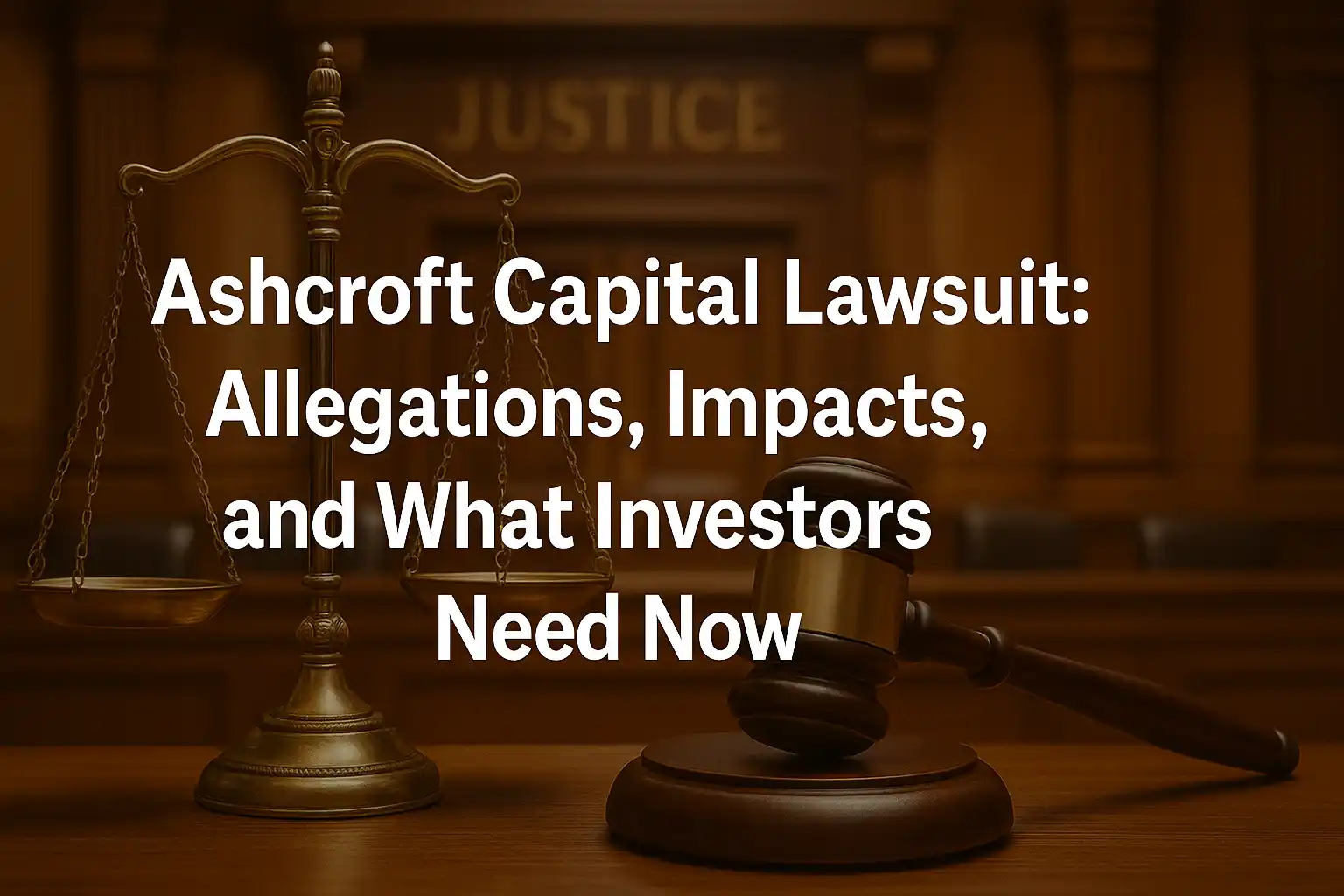Ashcroft Capital Lawsuit: Allegations, Impacts, and What Investors Need Now
Investing in real estate can feel like a dream—steady returns, passive income, and a slice of the property market. But when things go wrong, like with the Ashcroft Capital lawsuit, it’s a wake-up call that leaves investors rattled. Allegations of mismanagement and broken trust have sparked a legal battle that’s shaking the industry, leaving you wondering: How do I protect my money?
This guide simplifies the complex Ashcroft Capital lawsuit, breaking down the allegations, current status, and what it means for you. You’ll learn about the key issues, how investors are reacting, and practical steps to safeguard your investments. Let’s dive into the facts and empower you to navigate this storm with confidence.
What is Ashcroft Capital?
Before we unpack the lawsuit, let’s get to know Ashcroft Capital and why it matters.
Overview: A Leader in Multifamily Real Estate Syndication
Ashcroft Capital is a big name in real estate, focusing on multifamily properties like apartment complexes. They buy, renovate, and manage these buildings to boost value and generate profits for investors.
Business Model: Value-Add Investing and Investor-Funded Properties
Their strategy is “value-add”—think flipping houses, but for massive apartment buildings. They raise money from investors, spruce up properties, and aim for higher rents and returns. It’s a model that’s attracted thousands of investors.
Growth Story: Managing $2B+ in Assets Before the Lawsuit
Ashcroft scaled fast, managing over $2 billion in assets across the U.S. Sun Belt. Their pitch? Strong returns through smart investments. But rapid growth brought scrutiny, setting the stage for legal trouble.
Read more: Your Ultimate Guide to Radiant Body and Hand Care Rituals
The Ashcroft Capital Lawsuit: Background and Origins
How did a top firm end up in court? Let’s trace the roots of this legal battle.
How the Lawsuit Began: Investor Discontent
The trouble started when investors noticed issues with their returns. Some properties underperformed, and Ashcroft paused distributions—essentially halting payouts to investors. This sparked frustration and distrust.
Key Triggers: Paused Distributions and Capital Calls
Rising interest rates and costly rate caps (insurance against loan rate hikes) strained Ashcroft’s funds. They asked investors for more money through “capital calls,” which felt like a betrayal to many who expected steady returns.
Timeline of Events Leading to the Legal Battle
- Early Issues: Investors reported delayed financial reports and vague updates.
- Mid-Period: Ashcroft paused distributions on several funds, citing market challenges.
- Lawsuit Filed: A group of investors sued, alleging mismanagement and broken promises.
Read more: News PBLinuxTech: Your Ultimate Guide to Linux and Open-Source Innovation
Key Allegations Against Ashcroft Capital
What exactly are investors upset about? Here are the main claims fueling the Ashcroft Capital lawsuit.
Misrepresentation of Returns: Overly Optimistic Projections
Investors say Ashcroft painted a rosy picture, promising high returns without highlighting risks. For example, marketing materials hyped up unrealistic profit margins that didn’t match market realities.
Breach of Fiduciary Duty: Prioritizing Firm Profits Over Investors
Plaintiffs claim Ashcroft put its own interests first, like charging high fees or refinancing properties in ways that benefited the firm but hurt investors’ returns.
Financial Mismanagement: Unclear Fund Allocation and Reporting
Some allege Ashcroft misused funds, diverting money meant for property upgrades to unrelated expenses, like marketing or holding companies. Financial reports were often vague, leaving investors in the dark.
Lack of Transparency: Vague Updates and Omitted Risks
Investors felt blindsided by missing or unclear updates. For instance, occupancy rates or property issues weren’t fully disclosed, making it hard to gauge investment health.
Current Status of the Ashcroft Capital Lawsuit
Where does the lawsuit stand today? Here’s the latest.
Latest Developments: Ongoing Litigation and Settlement Talks
The Ashcroft Capital lawsuit is in the discovery phase, where both sides exchange evidence like emails and financial records. Settlement talks are rumored, but no deal has been confirmed.
Court Progress: Discovery Phase and Key Filings
Investors have filed in federal court, seeking compensation for losses. Ashcroft’s legal team has pushed to dismiss some claims, arguing that risks were disclosed and market conditions are to blame.
No Confirmed Payout: What Investors Can Expect
As of now, no payout or settlement has been finalized. Investors may face a long wait, with outcomes ranging from financial recovery to continued uncertainty.
Ashcroft Capital’s Response to the Allegations
How is Ashcroft defending itself? Let’s look at their side.
Official Stance: Denial of Wrongdoing and Market Blame
Ashcroft denies all allegations, insisting they operated ethically. They point to tough market conditions—like rising interest rates—as the real culprit, not mismanagement.
Legal Defense: Claims of Adequate Disclosures
Their lawyers argue that investment risks were clearly outlined in documents like the Private Placement Memorandum (PPM). They say investors knew real estate could be unpredictable.
Improvement Efforts: Internal Audits and Transparency Pledges
To rebuild trust, Ashcroft claims it’s conducting internal reviews and improving communication. They’ve promised clearer reports, but some investors remain skeptical.
Investor Reactions and Community Sentiment
The lawsuit has sparked a firestorm among investors. Here’s what they’re saying.
Real Investor Story: One LP’s Experience with Paused Distributions
Take Sarah, a retiree who invested $100,000 in an Ashcroft fund. When distributions stopped, she was stunned. “I relied on those payments for living expenses,” she shared. Vague updates left her feeling helpless.
Online Discussions: Reddit and BiggerPockets Forums
On platforms like Reddit and BiggerPockets, investors vent frustration. One user wrote, “Ashcroft’s capital calls feel like throwing good money after bad.” Others debate whether to join the lawsuit.
Growing Distrust: How the Lawsuit is Shaping Investor Views
The lawsuit has eroded confidence in Ashcroft and similar firms. Many investors now question syndicators’ promises, pushing for more transparency across the industry.
Impacts on Investors and the Real Estate Market
The fallout from the lawsuit goes beyond Ashcroft’s investors.
Financial Risks: Potential Losses and Delayed Payouts
Investors face delayed or reduced returns, with some worried about losing their principal. Properties may be sold at a loss if market conditions don’t improve.
Market Volatility: Shifts in Multifamily Investment Trends
The lawsuit has made investors wary of multifamily syndications, slowing capital flow into similar deals. This could cool the hot apartment market in the Sun Belt.
Reputational Damage: Ashcroft’s Struggle to Regain Trust
Ashcroft’s brand has taken a hit, making it harder to attract new investors. Competitors are capitalizing, pitching themselves as more transparent alternatives.
| Impact Area | Details | Investor Concern |
|---|---|---|
| Financial | Delayed payouts, potential losses | Will I recover my investment? |
| Market | Reduced trust in syndications | Are these deals still safe? |
| Reputation | Ashcroft’s damaged credibility | Can I trust their promises? |
Regulatory Implications and Industry Changes
The lawsuit could reshape how real estate syndications operate.
SEC Scrutiny: Potential for Stricter Syndication Rules
The Securities and Exchange Commission (SEC) is watching closely. If allegations hold, we could see tougher rules on disclosures and investor protections.
Tighter Regulations: Enhanced Reporting and Investor Protections
New regulations might require syndicators to provide detailed, timely reports and clearer risk warnings, reducing the chance of future disputes.
Industry Shift: Rise of AI-Based Risk Assessment Tools
Some firms are adopting AI to analyze deals and flag risks, like overleveraged properties. This tech could help investors make smarter choices.
How to Protect Your Investments?
Worried about your investments? Here’s how to stay safe.
Conduct Thorough Due Diligence: Key Questions to Ask
Before investing, ask: What’s the firm’s track record? Are their projections realistic? Dig into their past deals and read investor reviews.
Review Contracts: Focus on Risk Disclosures and Fees
Read the fine print in the PPM. Look for hidden fees or vague risk disclosures. I once skipped this step and regretted it—don’t make my mistake.
Consult Professionals: Legal and Financial Advisors
A financial advisor or lawyer can spot red flags. For example, my advisor caught a risky clause in a deal that saved me thousands.
Join Investor Networks: Share Insights and Updates
Forums like BiggerPockets connect you with other investors. Sharing experiences can reveal warning signs, like Ashcroft’s paused distributions.
Next Steps for Affected Investors
If you’re caught up in the Ashcroft mess, here’s what to do.
Stay Informed: Track Court Filings and SEC Updates
Follow case updates through legal news or investor forums. Knowing the latest helps you plan your next move.
Explore Legal Options: Joining the Lawsuit or Seeking Counsel
Consider joining the lawsuit or consulting a lawyer to assess your claims. Some investors are pooling resources for stronger legal action.
Diversify Investments: Reduce Reliance on Single Syndicators
Spread your money across different firms or asset types, like REITs. This lowers your risk if one deal goes south.
Prepare for Outcomes: Settlement, Ruling, or Reorganization
Be ready for any result—a settlement might bring partial recovery, while a loss could mean tougher financial hits. Plan your budget accordingly.
Lessons Learned from the Ashcroft Capital Lawsuit
This lawsuit offers hard-earned wisdom for every investor.
Importance of Transparency in Real Estate Syndication
Demand clear, frequent updates from syndicators. If they’re cagey, like Ashcroft allegedly was, it’s a red flag.
Risks of Overleveraged Deals in Volatile Markets
High debt can sink deals when rates rise. Ashcroft’s rate cap issues show why conservative financing matters.
Empowering Yourself with Knowledge and Skepticism
Don’t trust flashy pitches. Educate yourself on real estate basics and question everything. Knowledge is your best defense.
Conclusion
The Ashcroft Capital lawsuit is a stark reminder that even big-name firms can stumble, leaving investors in the lurch. From allegations of mismanagement to eroded trust, this case highlights the risks of real estate syndication. But it’s also a chance to take control—by staying informed, doing your homework, and diversifying your portfolio, you can protect your financial future.
What’s your take on the Ashcroft Capital lawsuit? Have you been affected, or are you rethinking your investments? Share your thoughts in the comments—I’d love to hear from you! For more insights, check out our related articles below.
Key Takeaways:
- Why It Matters: Allegations of mismanagement threaten investor trust.
- What to Do: Research thoroughly, consult experts, and diversify.
- Next Steps: Stay updated and explore legal options if affected.
FAQs
What is the Ashcroft Capital lawsuit about?
It’s a legal battle where investors accuse Ashcroft Capital of mismanagement, misrepresentation, and breaching fiduciary duty, claiming these led to financial losses.
What are the main allegations against Ashcroft Capital?
Investors allege overly optimistic return projections, prioritizing firm profits, misusing funds, and lacking transparency in reporting.
Has there been a payout in the Ashcroft Capital lawsuit?
No payout has been confirmed. The lawsuit is ongoing, with settlement talks in progress but no final resolution.
How will the lawsuit affect real estate syndication?
It may lead to stricter regulations, increased investor caution, and a push for transparency in how syndicators operate.
What can investors do to protect themselves now?
Conduct due diligence, review contracts, consult advisors, join investor networks, and diversify to reduce risks.







